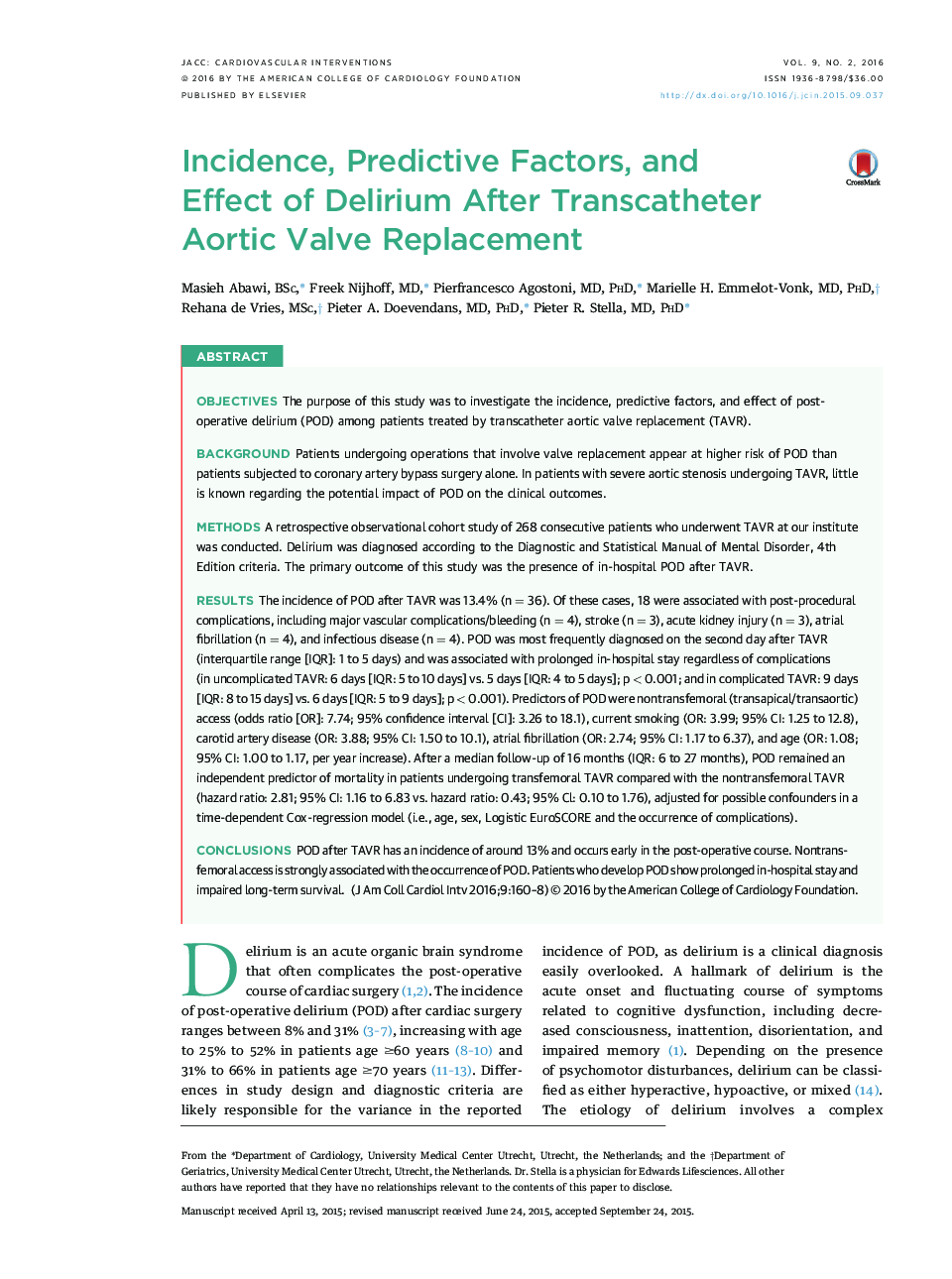| کد مقاله | کد نشریه | سال انتشار | مقاله انگلیسی | نسخه تمام متن |
|---|---|---|---|---|
| 2940041 | 1177011 | 2016 | 9 صفحه PDF | دانلود رایگان |

ObjectivesThe purpose of this study was to investigate the incidence, predictive factors, and effect of post-operative delirium (POD) among patients treated by transcatheter aortic valve replacement (TAVR).BackgroundPatients undergoing operations that involve valve replacement appear at higher risk of POD than patients subjected to coronary artery bypass surgery alone. In patients with severe aortic stenosis undergoing TAVR, little is known regarding the potential impact of POD on the clinical outcomes.MethodsA retrospective observational cohort study of 268 consecutive patients who underwent TAVR at our institute was conducted. Delirium was diagnosed according to the Diagnostic and Statistical Manual of Mental Disorder, 4th Edition criteria. The primary outcome of this study was the presence of in-hospital POD after TAVR.ResultsThe incidence of POD after TAVR was 13.4% (n = 36). Of these cases, 18 were associated with post-procedural complications, including major vascular complications/bleeding (n = 4), stroke (n = 3), acute kidney injury (n = 3), atrial fibrillation (n = 4), and infectious disease (n = 4). POD was most frequently diagnosed on the second day after TAVR (interquartile range [IQR]: 1 to 5 days) and was associated with prolonged in-hospital stay regardless of complications (in uncomplicated TAVR: 6 days [IQR: 5 to 10 days] vs. 5 days [IQR: 4 to 5 days]; p < 0.001; and in complicated TAVR: 9 days [IQR: 8 to 15 days] vs. 6 days [IQR: 5 to 9 days]; p < 0.001). Predictors of POD were nontransfemoral (transapical/transaortic) access (odds ratio [OR]: 7.74; 95% confidence interval [CI]: 3.26 to 18.1), current smoking (OR: 3.99; 95% CI: 1.25 to 12.8), carotid artery disease (OR: 3.88; 95% CI: 1.50 to 10.1), atrial fibrillation (OR: 2.74; 95% CI: 1.17 to 6.37), and age (OR: 1.08; 95% CI: 1.00 to 1.17, per year increase). After a median follow-up of 16 months (IQR: 6 to 27 months), POD remained an independent predictor of mortality in patients undergoing transfemoral TAVR compared with the nontransfemoral TAVR (hazard ratio: 2.81; 95% CI: 1.16 to 6.83 vs. hazard ratio: 0.43; 95% Cl: 0.10 to 1.76), adjusted for possible confounders in a time-dependent Cox-regression model (i.e., age, sex, Logistic EuroSCORE and the occurrence of complications).ConclusionsPOD after TAVR has an incidence of around 13% and occurs early in the post-operative course. Nontransfemoral access is strongly associated with the occurrence of POD. Patients who develop POD show prolonged in-hospital stay and impaired long-term survival.
Journal: JACC: Cardiovascular Interventions - Volume 9, Issue 2, 25 January 2016, Pages 160–168